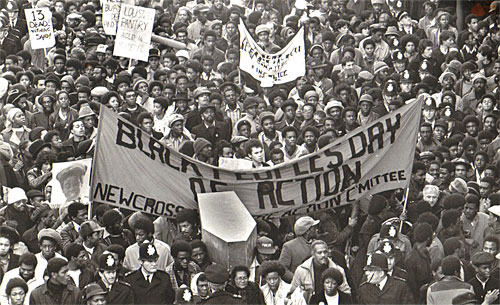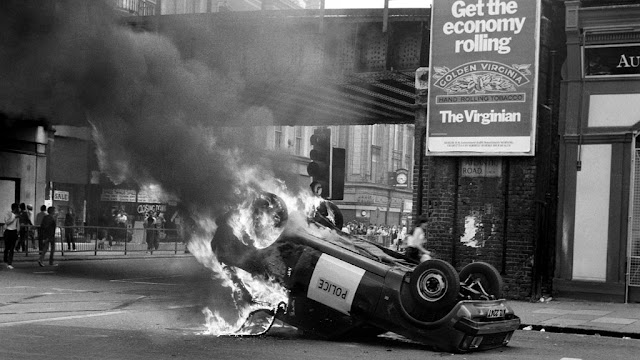THE
BRIXTON RIOT
By 1981, if the
communities within the inner cities weren't already potential
time-bombs waiting to explode, they certainly were after suffering
two years of Thatcherism and increasing police prejudice.
Racial tensions in
London were further stoked when a fire took place at a house in New
Cross, leaving 13 young black people dead. Family members, friends
and neighbours all felt the police simply weren't doing enough to
establish what the cause of the fire was, particularly after it was
suggested it may have been arson perpetuated by racists. In any other
circumstances the deaths would have been considered a national
tragedy but the event went hardly acknowledged by the authorities. In
any other circumstances The Queen would have typically sent a message
of condolence but instead there was silence. It seemed to the black
community that if the victims had been white, perhaps the police and
the media would have been more sympathetic and taken the incident
more seriously.
As an expression of
dissatisfaction and protest against the apathy as shown by the police
and authorities regarding the deaths, a Black People's Day of Action
was held and up to 20,000 people marched from the borough of Lewisham
to central London; chanting and bearing placards with the words
'Thirteen dead, Nothing said'. The march was noisy but peaceful and
viewed as a symbolically significant moment for Britain's black
community for this was the first time they had ever amassed on the
streets in such numbers. The next day's papers, however, depicted the
event somewhat differently.
Unbeknownst to most
people on the march, a fight had broken out between some black youth
and the police and though it was an isolated incident and over very
quickly, it was this that led the newspaper headlines. Darcus Howe
had been asked his view of the demonstration and he had replied "It
was a good day". His quote was used by the Evening Standard
as a headline but juxtaposed with a photo of an injured police
officer and it was this that was used to characterise the entire day.
Other headlines read 'Black day at Blackfriars', 'When the black tide
met the thin blue line', and 'Day the blacks ran riot through
London'.
It was unbelievable.
You couldn't make it up.
For many, the final
straw came with Swamp 81, the name given to a police operation
conducted in London that involved flooding specific areas with police
in a bid to hunt down muggers and robbers. As nobody likes a mugger
this was all well and good although as one of the main areas targeted
was Brixton, to call the operation 'Swamp' was a tad insensitive as
it was an obvious echo of Thatcher's pre-election comments regarding
white neighbourhoods fearing being swamped by minorities. It didn't
help matters that many entirely innocent people were being stopped,
searched and arrested for no apparent reason, it appeared, other than
being black. In Brixton, 1,000 people were stopped in just five days.
It was one such
incident involving the harassment and arrest of a black taxi-driver
that was the spark that caused Brixton to erupt into a riot that
lasted for three days that saw the first widespread use of petrol
bombs on the British mainland.
As in Bristol
exactly one year before, objections from a crowd suddenly escalated
from the verbal to the physical, to the throwing of missiles to
full-blown riot. Unlike Bristol, however, the Commander in charge of
the police was determined not to have his officers forced out of the
area by the mob even under the most ferocious of assaults and the
most dangerous of circumstances, choosing instead to remain on the
streets and to suffer the consequences. In a bid to retain control
3,000 police officers from different areas were bussed into Brixton
immediately though all to no avail.
A torrent of
missiles were rained down upon the police lines - bricks, stones,
bottles, pieces of iron, paving slabs, petrol bombs, even glass china
plates. At one point whisky was poured over police riot shields in a
bid to set them alight. Police cars, police vans and private vehicles
were overturned and set on fire. Barricades were erected from
overturned cars and corrugated iron. A car and even a hi-jacked bus
was driven and pushed as battering rams into police lines. Wheelie
bins were set alight and then pushed at the police. Youngsters
taunted the police causing them to chase after them, only to lead
them into dead ends where their friends waited to ambush them with
volleys of bricks. Houses, shops and pubs were looted and burnt out.
The police were battered, hammered and ultimately beaten.
Although complete
disorder seemed to reign it was apparent there was a logic to the
violence, evidenced by the properties that went untouched. Certain
pubs and shops were left as smouldering ruins while others were left
totally alone. The local anarchist squat/bookshop at 121 Railton
Road, for example (which just so happened to be sporting a poster of
the Bristol riot in its window), was left without a scratch.
By the end of the
riot, Brixton was a scene of utter devastation. 60 civilians had been
arrested but over 300 policemen had been both injured and
hospitalised. Burnt-out cars littered the streets and buildings stood
burnt-out, looted or damaged. 56 police vehicles had been destroyed.
To the black community the riot would for ever more be known as 'The
Insurrection' or 'The Uprising' but for the Metropolitan police it
would be known as the first most serious riot of the 20th century.
According to the
then Metropolitan police commissioner Sir David McNee and various
reports in the newspapers, the violence in Brixton had been
instigated by "trouble-makers from elsewhere" though
no evidence was ever proffered to substantiate this. Much more likely
was that the main influence upon the riot was the St Paul's riot in
Bristol a year earlier which if nothing else had served as an
inspiration. It would have been more relevant in actual fact for the
police to have wondered why - following the Bristol riot - had it
taken so long for Brixton to do likewise? But instead it seemed as if
they preferred to apportion blame upon shady individuals, at one
point even raising suspicion about the anarchists lurking within 121
Railton Road.
One thing for
certain, however, was that Britain's most infamous anarchists at that
time - Crass - had absolutely nothing to do with it. Though
sympathetic to the anger and the reactions of the rioters to their
conditions, Crass felt that rioting would only serve to increase the
forces and modes of oppression.
In the official
investigation (The Scarman Report) that followed the riot it was
indeed stated that the police needed to be better organised for riot
control, while the Met would later announce that many important
practical lessons had been learnt from the experience which they
would apply to any such future riots. Sir David McNee was also to put
in a request as a matter of urgency for proper riot equipment which
included a greater variety of shields, more vehicles, longer
truncheons, water cannon and sufficient stocks of rubber bullets. At
a grass roots level it also left the police wanting revenge. So in
effect, Crass were correct though that's not to negate the very
positive aspects of the Brixton riot:
Never again would
the police feel so easily able to surge into a community such as
Brixton; stopping, searching and arresting people on the most
flimsiest of pretexts.
Never again would
the police feel so easily able to blatantly disrespect the black
community without also knowing of the risk being run.
And if any other
community ever felt in the words of Discharge that they'd "been
shit on for far too long", an example had been set about
what could be done about it and what the authorities could expect as
a result...




I'm thoroughly enjoying these posts (if enjoying is the right word - but hopefully you know what I mean!). It is - or should I say, is it ? - a book in the making?
ReplyDeleteThank you, C, you're very kind. I was thinking the same, actually, that it's looking like a book. It wasn't my intention though. I was thinking just yesterday actually that perhaps I should turn it into a one-off fanzine? I'll see how it goes as there's a lot more to write about yet.
Delete